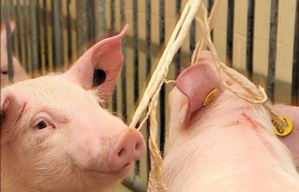



PRRSV – the importance of monitoring the virus and your herd
Diagnostic solutions for one of the most damaging diseases of the swine industryDespite the amount of research that has been completed on porcine reproductive and respiratory syndrome (PRRS), there is still much to learn about this disease. PRRS is one of the most economically significant infectious diseases in swine globally, accounting for annual losses of about $2.5 billion in the US and Europe, according to a study by the University of Edinburgh.1
The disease is caused by PRRS virus (PRRSV), which is an enveloped single-stranded positive-sense RNA genome of about 15 kilobases. PRRSV belongs to the family Arteriviridae within the order Nidovirales. PPRSV is endemic in most pig-producing countries. The only countries thought to be PRRSV-free include Switzerland, Sweden, Norway, Finland, Australia, New Zealand, Argentina, and Brazil.
Mutations and Genetic Diversity of the Virus Make it a Challenge to Monitor
One of the challenging components of PRRSV is its highly mutating nature, which creates new circulating strains that must be continuously monitored. Two primary genotypes are recognized: PRRSV-1 (previously known as Type 1 and the European strain), and PRRSV-2 (previously known as PRRS Type 2 and the North American strain).
PRRSV-1 – the predominant strain found in Europe.
It is known to mainly cause subclinical coinfections, but subtypes can be more virulent and pathogenic. Because of the role coinfections play with PRRSV-1, it’s critical to conduct diagnostic analysis to identify all pathogens causing infection. Since it was first identified, its diversity has increased, creating highly variable strains in Europe. Research has identified three major European clusters—Lelystad-like isolates, purely Danish isolates, and highly diverse Italian-like isolates—and four subtypes that each present different clinical signs.
PRRSV-2 – the predominant strain found in North America.
Highly pathogenic PRRSV-2 (HP-PRRSV) originated from PRRSV-2 and was identified in 2006 in China amid a devastating outbreak that affected about 2 million pigs with 400,000 dying. HP-PRRSV has also been detected in Vietnam, Laos, Thailand, Cambodia, and India. Overall, nine genetic lineages of PRRSV-2 have been identified with varying virulence.
PRRSV-1 and PRRSV-2 emerged within three years on separate continents and caused similar outbreaks. Although they share some structural similarities, their molecular and antigenic variation is surprisingly significant; thus, they were defined as two separate species.
Clinical Signs and Treatment
PRRS is a viral disease that leads to third-trimester abortions, stillbirths, neonatal deaths, weak-born piglets, and increased mortality in suckling and weaned piglets. There is also respiratory disease, which can range from mild to severe, but typically turns severe when other disease agents are present, which can result in high death rates in suckling and weaned pigs. In boars and unbred gilts and sows, fever, listlessness, and anorexia are typically observed.
The disease intensity seems to fluctuate based on the isolate or strain. PRRSV destroys up to 40 percent of the pig's macrophages, removing a significant part of the pig’s defense mechanism and exacerbating secondary infections like Influenza A, Streptococcus suis, and Mycoplasma pneumoniae, which appear to enhance the duration and severity of PRRSV-induced pneumonia and lung lesions.
Multifactorial Approach is Necessary to Prevent PRRSV
Biosecurity Standards, Diagnostic Surveillance, Herd Immunization
There is no medication available to treat PRRSV. However, vaccination can limit clinical symptoms and reduce virus shedding. Prevention of PRRSV is multifactorial and includes incorporating biosecurity standards, ongoing diagnostic surveillance, and immunization as recommended by a veterinarian.
Ongoing Surveillance Is Key to Identifying an Outbreak
Even though farm staff and veterinarians know what signs to look for, PRRSV symptoms can mimic several other pig diseases. Thus, ongoing monitoring for PRRSV is critical to the success of every herd. Testing also supports modern herd management and achieving a high level of biosecurity by helping to quickly identify the virus and help the herd’s team identify the source of infection. PRRSV’s remarkable genetic variation makes on-farm sampling and in-lab epidemiological and molecular analysis critically important to help the global pig industry monitor changes of the active circulating viruses.
RT-qPCR for Accurate and Fast Diagnostics
High Specificity and Sensitivity

One of the most commonly used diagnostic monitoring tools for detection of PRRSV nucleic acid is quantitative reverse-transcription polymerase chain reaction (RT-qPCR). RT-qPCR is highly accurate, offering high specificity and sensitivity as well as rapid evaluation of current infection status. Results can typically be obtained in just a few hours.
The diagnostic tests are commonly used to detect nucleic acid in serum, whole blood, semen, tissue, oral fluid, and processing fluids. RT-qPCR also allows sampling in pools of up to five samples using serum and whole blood samples. Newer sampling options like oral fluids require less labor and are a more animal-friendly means of gathering a sample.
Other Diagnostic Options
Other diagnostic tools are also available like ELISA testing, which uses antibodies to identify the prevalence of infection within a pig population. Nucleic acid sequencing is another testing option that can help producers and veterinarians track the virus and better understand its distribution in a pig population after an outbreak.
Considering the complex diversity of PRRSV, additional genome sequencing is needed to better understand, control, and eventually eliminate this devastating disease.
Learn More About PRRS Diagnostic Testing Solutions
Diagnostic Solutions That Evolve With Your Needs - We can partner with your lab to design a solution that adapts to your evolving needs and produces actionable PRRSV (porcine reproductive and respiratory syndrome virus) test results.
Porcine/Swine Diagnostic Solutions - Applied Biosystems branded solutions offer fast, scalable, and accurate performance to help ensure that you can stay ahead of any pathogenic outbreak.
Development of Updated Porcine Reproductive and Respiratory Syndrome Virus Products [PDF] – Due to the highly mutating nature of PRRSV and newly circulating strains, a project was launched to update the currently on-market PRRSV products with a new molecular design to provide improved detection toward the new variants.
Watch Animal Health Videos About PRRS – diagnostics, testing, emerging strains and diseases, swine herd health, biosecurity and economics.



